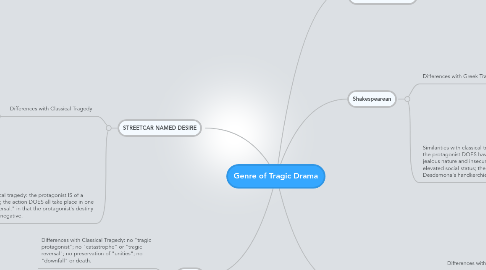
1. STREETCAR NAMED DESIRE
1.1. Differences with Classical Tragedy
1.1.1. Blanche is not "virtuous" and is, rather, pathetic, and to be pitied.
1.1.2. The "TRAGIC PROTAGONIST" is not destroyed, but, instead, is raped and goes mad.
1.1.3. Blanche is always aware of her weaknesses, but never RECOGNIZES her own responsibility for indulging them.
1.1.4. Blanche, unlike Oedipus, Othello, Hamlet or even Dysart, cannot be taken at her word.
1.1.5. There is too great a social dimension of the tragedy and insuffient emphasis on individual choice and responsibility for the REVERSAL.
1.2. Similarities with classical tragedy: the protagonist IS of a superior social station; the action DOES all take place in one locale; there IS a "reversal," in that the protagonist's destiny goes from positive to negative.
2. EQUUS
2.1. Differences with Classical Tragedy: no "tragic protagonist"; no "catastrophe" or "tragic reversal"; no preservation of "unities"; no "downfall" or death.
2.2. Similarities with classical tragedy: ritualistic; violent; contains a "recognition," when Dysart realizes that he doubts the worth of his therapy and his world-view; protagonist is not the least bit self-sacrificial, and is not in a position to be; contains a chorus of "horses," but who do not comment intelligibly; there is a mythical dimension of the action, which refers to both classical myth and the "myths" of modern Freudian psychology.
3. Classical Tragic Drama, according to Aristotle's POETICS
3.1. The HERO, who must suffer pain/death , must be "above the middling condition," and need not be eminently good or virtuous, and he must be "flawed" but not "unjust" and not untruthful. (His "error" may be just in judgment, as in not recognizing or accepting his own frailty) Additionally, the TRAGIC HERO who is a leader accepts his self-sacrificial role in society, as Oedipus does.
3.2. The "TRAGIC HERO" must perceive his error or weakness during the "falling action" of the play.
3.3. A REVERSAL of the fortunes of the Tragic Protagonist must take place, usually at the CLIMAX of the Action.
3.4. The "ACTION" of the play must be "of a whole," and occur during a short--usually 24 hr.--period, and it must take place in one single locale.
3.5. A "Catharsis" or PURGING of the audience's fear and pity must occur, inducing socially efficacious acceptance of man's spiritual condition of frailty or weakness.
3.5.1. There is a CHORUS that enunciates the audience's PITY and FEAR.
3.6. The subject material usually comes from Greek classical mythology
4. Shakespearean
4.1. Differences with Greek Tragedy
4.1.1. OTHELLO is a commander of great strength and virtue, but not the chief man of the Venetian state.His tragedy is private and domestic, and not public like Oedipus's is, and so he is not called upon to be an offering for his people, as HAMLET is.
4.1.2. The "UNITIES" are NOT observed, because the ACTION takes place in more than one place, during a period longer than 24 hours.Also, that ACTION is not a "whole," because there is an additional focus on other characters.
4.1.3. The TRAGIC ANTAGONIST is not a "god" or the "Fates," but, rather, a fascinating villain, who is a "demon figure" in OTHELLO.
4.1.4. No CHORUS
4.2. Similarities with classical tragedy: the protagonist DOES achieve "recognition"; the protagonist DOES have a "flaw," which is his inability to "recognize" his jealous nature and insecurities in the Venetian milieu; the protagonist IS of elevated social status; there is "hamartia," or "missing the mark"--as with Desdemona's handkerchief.
5. DEATH OF A SALESMAN
5.1. Differences with Classical Tragedy
5.1.1. The TRAGIC PROTAGONIST is a pathetic, weak man, who never RECOGNIZES his own responsibilty in incurring his REVERSAL. He's also physically debilitated and unreliable, which never would have been the case with a Greek or Shakepearean protagonist.
5.1.2. A secondary character, Biff, achieves the RECOGNITION that the protagonist should have.
5.1.3. The ACTION is not public and the UNITIES are not preseved, because of the many flashbacks and the "theatre" of Willy's mind.
5.1.4. The CHORUS is replaced by ghostly figures of Willy's past life, who serve to remind him of his failings and lost opportunities, for which the PROTAGONIST feels regret, but little responsibility.
